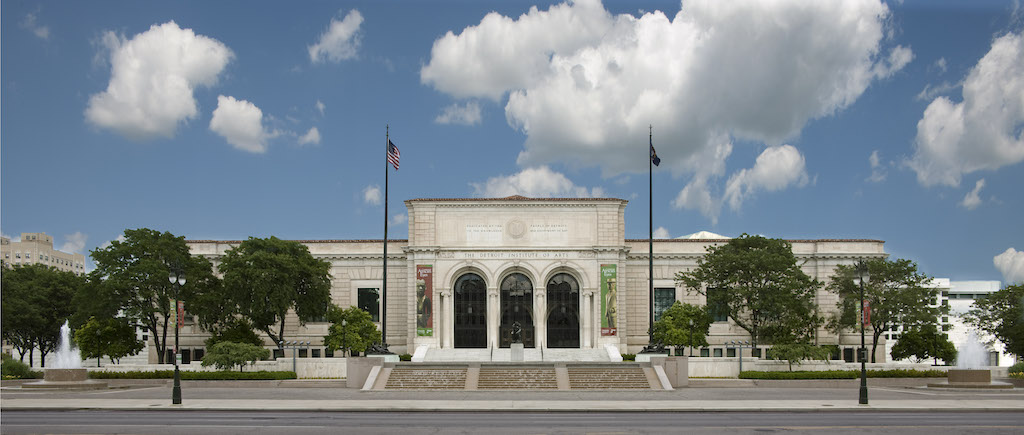
Street closures, new plaza? Radical changes could be coming to layout of Detroit's Cultural Center
City asking for public input on three design proposals
Radical changes to the City’s cultural center, which could include permanent street closures, reconfiguring lanes on Woodward Avenue and changing building entrances for some of the area’s most prominent institutions, could be coming in the next few years in an effort to create more accessible public space.
With public input, City of Detroit Planning Director Maurice Cox says three design firms from across the world are participating in an “ideas competition” to give the cultural center “its sense of place.”
The cultural center, defined by the area that comprises of the Detroit Institute of Arts, the Wright Museum, Detroit Public Library’s Main Branch, the Detroit Historical Museum, the Michigan Science Center and some Wayne State University and College for Creative Sciences buildings, is a “mini-Smithsonian,” Cox says. “The collection of cultural institutions within walking distance of each other is second only to the Smithsonian’s collection at the nation’s mall. “
But because the area was developed over decades, there is no cohesion between each of the institutions. “A lot of the spaces in between the institutions are not very welcoming to people.”
Woodward Avenue ballooned to a six-lane thoroughfare from the time the DPL settled into its current location in 1921 (with the DIA coming into its current location just six years later) until now. Along the way came the Detroit Historical Museum (in its current location since 1951), the Michigan Science Center (1978) and the Wright Museum (1997).
Differences in architectural styles aside, traversing from one location to the next is intimidating, Cox says. The front door of the Michigan Science Center leads to the back of the Wright Museum, for example. The stairs heading up to the DIA, long a backdrop for photoshoots, can also feel cold — and only lead to one front door.
“Some of the buildings are built at the beginning of the 20th century. The public library and the Detroit Institute of Arts have a very clear relationship with each other. Woodward wasn’t always this unpassable street, so instead of connecting those two institutions, |LS|Woodward|RS| kind of divides them,” Cox says. “But then you have more recent buildings like the science museum and the Charles H. Wright Museum that really were not riffing off of each other, (not) trying to create real space between each other. So as a result, they kind of act as islands.”
"I think one of the challenges is that we can’t change the architecture, but we can change the nature of public space.”
The firms, which will present their plans to the public this week, were asked to “think outside the box” when it came to making the area more accessible. That could mean closing down some of the east-west streets such as Kirby or Ferry, creating a plaza similar to Spirit Plaza — anything to make the institutions, particularly the DIA, more welcoming.
“The teams are very different.,” Cox says, noting one is from Asia, one is from Paris and one is from the United States. “All of them have very local Detroit participation, so they have historians and planners and architects of color on their team, and they really brought home the point that the DIA is a resource for everyone, not just the region but everyone in the city.”
Though public spaces and events in Midtown and the cultural center attract thousands of black Detroiters — DPL Main is the second-most visited building in the area with 500,000 annual visitors and the African World Festival at the Wright Museum is the second-most patronized annual event with 150,000 visitors — many of them still feel more like regional destinations rather than attractions for city residents.
The goal is “to create a place where whether you go into the buildings or not, you feel welcome. You know you can hang out there, get a cup of coffee, meet up with some friends, see a concert and currently there is no place where that can happen. There’s more parking lots than places for people,” Cox says.
“If anybody dare say that Midtown doesn’t belong to African-Americans, they need to spend some time in the public library on Woodward,” Cox says. “The same with the DIA. I can’t tell you the number of stories from African-Americans who remember their parents taking them to the DIA, and that’s where they learned to love art. Those institutions are as much a reflection of who Detroit is and the inclusion we aspire to have as anything else, but it still looks like this marble edifice with these big stairs and one door, and I think that sends the wrong signal. I think one of the challenges is that we can’t change the architecture, but we can change the nature of public space.”

